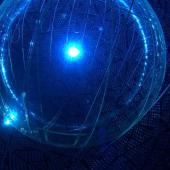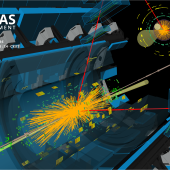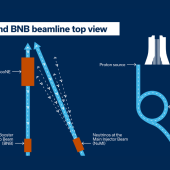We bring together world-leading experimental and theoretical research to explore the most fundamental constituents of our Universe and the forces acting between them.
The major science themes that we pursue are:
- the study of the Higgs boson and search for new physics with accelerators at the energy frontier
- matter-antimatter asymmetry, rare phenomena, and new interactions at the intensity frontier
- unveiling the physics of neutrinos
- exploring the dark universe (dark energy and dark matter)
- fundamental physics exploration enabled by quantum technologies
The energy frontier
High energy colliders and particle detectors explore the smallest distances and highest energies. The first goal is to produce and study previously unknown particles. The second is to discover new phenomena indirectly by measuring small deviations in the properties of known particles, for example the Higgs boson, from the predictions of the standard model of particle physics.
Our experimental programme at the high-energy frontier focuses on the ATLAS experiment at CERN LHC and our theorists develop high precision standard model predictions.
The intensity frontier
Very high-intensity beams and advanced instrumentation search for rare processes enhanced by previously unknown virtual particles in quantum loops. These experiments are sensitive to physics at energy scales far higher than those accessed directly at colliders, and also measure the small asymmetries between matter and antimatter that lead to a matter-dominated Universe.
Our experimental programme at the intensity frontier includes: LHCb, Beijing Spectrometer III (BES III), and Mu3e. Theorists search for explanations for deviations from the standard model, and for the matter-antimatter asymmetry.
The physics of neutrinos
Neutrinos are produced by many astrophysical sources and are among the most abundant particles in the Universe. They can also be created in reactors and accelerators. They are extremely light and interact with matter through the weak interaction and gravity. Understanding their properties is critical to our understanding of the origin of matter and the early evolution of the Universe.
Our experimental programme in neutrino Physics includes: T2K, Super-Kamiokande, Hyper-Kamiokande, MINERvA, SNO+, DUNE, and protoDUNE. Theorists use neutrino phenomenology to constrain extensions to the standard model.
The dark Universe
Cosmological observations show that roughly 68% of the Universe is dark energy, 27% dark matter and only 5% is made of familiar atomic matter. Dark matter does not emit detectable radiation and only rarely interacts with ordinary matter. Dark energy is responsible for the acceleration of the expansion of the universe. The nature of dark matter and dark energy is a mystery.
Our experimental programme to explore the dark universe includes LUX-ZEPLIN (LZ), the Rubin Observatory and the Atom Interferometer Observatory and Network (AION) and theorists develop mathematical models to explain these phenomena.
Fundamental physics and quantum technologies
Technologies such as quantum sensors have the potential to radically change our approach to understanding the Universe as they are extremely sensitive to ultra-light dark matter and gravitational waves.
Our experimental and theoretical programme on Quantum Sensors for Fundamental Physics is focused on AION and MAGIS at Fermilab.



